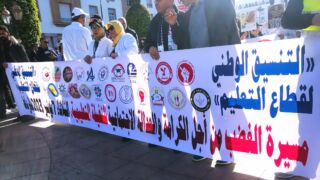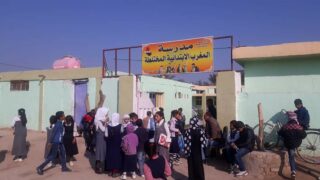It’s a celebration. The neighborhood’s children, like other children in the village, stand by awaiting the “opening ceremony.” I put on my new clothes. On the left side of my Maghrebi gown hung a small oval picture, which I remember to this day: It was a picture of the king.
It was the Day of the Throne. On the eve of the celebration, we brought palm leaves from the fields. Then, we prepared the celebration’s main stand, from where we would offer tea, lemonade and candy.
The stand was built from palm leaves. We were children who didn’t care how we behaved. It took us a long time to understand that the intensity and significance of what was happening could not be explained by chance.
What is the “Day of the Throne”?
The expression “Eid al-Orsh” [Day of the Throne] cannot be easily translated into another language without losing some its meaning. I used to think that the throne referred to the chair upon which the king sits. That’s partly true, but it is a little more complicated.
A sloping branch is called an “orsh” [throne]. The orsh is basically the ceiling, so a group of interlocking branches are called a throne because of the shade they create. This imagery alludes to the parental authority that protects the children. The throne also symbolizes the leader. It is very likely that the word “orsh,” which has been imparted on both the tent and the palace, initially referred to the ruling authorities.
So our structure, which was built from palm leaves, carried with it a lot of history. It stored a kind of memory about a ruling authority. Behavior that intense from children should cause one to think, especially when no authority interfered in it and when that authority is oblivious to the true meaning of the activity. That activity showed unawareness about the relationship with the authority, without drawing any special notice. Who would have thought that in the morning of that day a bunch of children were re-establishing an authoritarian relationship by simply building a structure that symbolized the throne of ancient tribes?
The relationship with the father, the relationship with the king
So building a structure with palm trees involved renewal, or a relinking with the ruling authority in its primitive form: the link of parental authority. Moreover, the construction of the structure by children referred to the emotional part of the link, which is mixed at birth with the relationship with the father; thus legitimizing the power relationship with the authority by portraying it as part of family solidarity and the father’s protective role. Those kind and warm acts solidify the embryonic link with the authority, which will then produce its successive changes. What could be more natural than bending to kiss the hand of the father as a strong expression of love and gratitude toward him? What we have in front of us are the roots of loyalty.
So these outbursts are explained by the close relationship with the father. We find this aspect of loyalty — which descends from the action of the ruler — similar to what drives us to kneel in front of the persons whom we love, especially the father. For the authority, loyalty is synonymous with distance, given the rule’s widespread influence. Being close to the head of the family in a nuclear family structure takes other forms and patterns when they are reproduced in a much larger structure. Thus, the transition that happened slowly, over history, from the micro scale to the macro scale, may have extended in a subtle way the pattern of physical expression of submitting to the father, to the relationship with the king.
That was the meaning of the celebration by the post-independence children on that morning in a remote village, as they declared loyalty, naturally and without raising any suspicion. It was as if the ruling authority had just been born in that era and is able to claim this amount of affection by children. That was the celebration that the children were commemorating. It embodied all the innocence found when submitting to the father.
Another society … other representations
Since then, things changed a lot. Demography has affected the old societal structures that were the guardians of the traditional seeds of the relationship with the ruling authority. Urban residents now outnumber rural people, who are no longer intellectually isolated. Kissing hands is no longer the norm in families, where the child/king now has more power. The modern school has undermined the foundations of representations of the authority from what it was in the previous generation. The new authority structures, in light of a state apparatus that is separate from society, and a royalty with many circles around it, are all factors that reinforce the distance between the individual and the ruling authority.
Loyalty, as it is structured today, and the kissing of the hand, which come from the same logic, can no longer be understood in the same way as before. The ruling authority is at the same time far and near due to the spread of the media. The ruling authority pictures itself in a way that is not exactly in tune with the new social model. Today’s youth cannot visualize a structure made of palm leaves nor its inauguration. They have lost that memory. The reasons for that are much deeper and more structural than suggested by the prevailing and superficial treatment of those questions.
Translated by Al-Monitor



